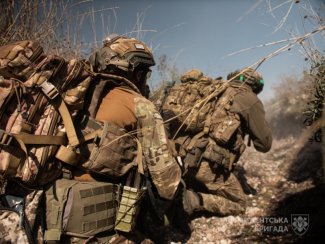Ukrainian activity on the Dnieper’s left bank. Day 607 of the war

The Russians have fortified their positions on the north-eastern outskirts of Avdiivka, and made further attempts to break through the Ukrainian defences to the north-west, south and south-west of the town. Ukrainian forces tried to counterattack in the area of Opytne south of Avdiivka; the head of the town’s military administration reported that the only road which can supply it in the western direction had come under artillery fire from the enemy along a 22-km stretch. There are still 1600 residents (out of a pre-war population of 32,000) in Avdiivka who are said to be refusing to evacuate, despite the difficult conditions.
In the vicinity of Bakhmut, both sides have managed to make slight advances in the field. Ukrainian forces have pushed the Russians out of several positions east of the Bakhmut-Horlivka railway line in the area of Andriivka, while the Russians have done the same on the line’s western side, north of Kurdiumivka. The invading forces also succeeded in seizing some of the areas near the Berkhivka reservoir north-west of Bakhmut which the defenders had previously recaptured. The remaining children were compulsorily evacuated from the Ukrainian-controlled villages in the Bakhmut region. A succession of Russian attacks to the north and south-east of Kupyansk, on the border of Luhansk and Kharkiv oblasts (mainly near Nadiya), south-west of Kreminna, in and around Marinka, on the border of Donetsk and Zaporizhzhia oblasts (south and south-east of Velyka Novosilka) and south-east of Orikhiv (mainly in the area of Mala Tokmachka) failed to bring about significant changes. The Ukrainians’ renewed attempts to break through Russian defences south of the latter village also failed.
Ukrainian forces have made further attempts to land sabotage and reconnaissance groups on the left bank of the Dnieper in the occupied part of Kherson oblast. According to some sources, they have re-occupied the village of Krynky west of Novaya Kakhovka, and now control part of its territory. Clashes near the railway bridge east of Kherson city were also said to have occurred. In addition, the defenders are maintaining a bridgehead in the area of the destroyed Antonivka road bridge. On 23 October, the military administration of Kherson oblast ordered a “compulsory evacuation in a forced manner” of residents from villages on the right bank of the Dnieper, from Kherson to Zolota Balka; families with children had been ordered to evacuate a month earlier.
On 21 October, Kharkiv and its surroundings came under attack from Russian missiles. In the village of Korotych near Kharkiv, two missiles from S-300 systems destroyed the logistics terminal of the Ukrainian national postal service, killing six and injuring 17 people working there. The invaders’ missiles also struck in the Voznesensky raion of the Mykolaiv oblast. Combined attacks (with Iskander-K cruise missiles and Shahed-136/131 kamikaze drones) were also launched at Kryvyi Rih, where some industrial infrastructure was destroyed. According to the Ukrainian General Staff, the invaders used a total of six missiles on 21 October. The following day, Russian missiles hit Kostiantynivka in Donetsk oblast and Zatoka in Odesa oblast, while kamikaze drones hit various sites in Khmelnytskyi oblast. The Ukrainian General Staff reported that the enemy used a total of 10 missiles, and according to communiqués from the Ukrainian Air Force Command, the defenders shot down one Kh-59 missile (the invaders also used eight S-300 missiles) and three or four Shahed-136/131 drones (all of those used in the attack).
On 23 October, Russian missiles fell on the Synelnykove raion of Dnipropetrovsk oblast (a power line was damaged) and one of the heating plants in Donetsk oblast, damaging the facility. Russian drones also struck Odesa oblast, where falling debris damaged warehouses in the port. The Air Force Command claimed to have shot down all 13 kamikaze drones used, as well as two missiles (including one Kh-59). According to the General Staff, the enemy used a total of four missiles on that day.
On 24 October, Russian missiles hit Zaporizhzhia, and again in the Synelnykove raion, where an infrastructure facility was damaged. During the night, Shahed-136/131 kamikaze drones attacked targets in Vinnytsia and Khmelnytskyi oblasts (probably the air base in Starokostiantyniv), most likely without success. The General Staff of the Ukrainian army reported that all six drones were shot down.
According to Russian sources, Ukrainian strikes targeted Sevastopol: on 22 October explosions were reported in the area of Kozacha Bay, and two days later it was reported that three submarine drones were destroyed while attempting to attack ships of the Black Sea Fleet. Meanwhile on 23 and 24 October the media and authorities in Rostov-on-Don reported a series of attacks by Ukrainian drones (which were probably shot down).
On 22 October, Ukraine’s ambassador to Washington Oksana Markarova announced that the White House had sent a budget request to the US Congress proposing to spend $61.4bn in aid for Ukraine. Defence spending would amount to $46.1bn, of which $30.6bn would be for programmes run by the Department of Defense ($18bn to replenish the US Army’s stockpile and $12bn for purchases under the Ukraine Security Assistance Initiative). A further $1.7bn would be spent on military support for Ukraine and those partners of the US whose security has been affected by the Russian invasion of Ukraine under the State Department’s Foreign Military Financing programme; meanwhile $14.4bn would be spent on technical, reconnaissance and cyber security support for Kyiv, as well as the increased production of arms and military equipment.
The day before, the media reported that the Ukrainian army had received a consignment of upgraded MRAP Senator armoured vehicles from Canada. On 20 October, the German Chancellery announced a new military support package for Kyiv, which included three Gepard self-propelled anti-aircraft guns, one Biber armoured bridgelayer, three HX81 trucks with trailers, 20 RQ-35 Heidrun and 20 Vector reconnaissance drones, and 3872 155-mm smoke shells.
On 20 October, Russian news agencies confirmed that Colonel General Viktor Afzalov had become the new commander of the Aerospace Forces (VKS). His predecessor Sergei Surovikin, who was also the deputy commander of the forces fighting Ukraine, was dismissed after Yevgeny Prigozhin’s mutiny in the summer. Afzalov is a graduate of the Air Defence Academy and the General Staff Academy. In 2017 he commanded the Air Force of the Eastern Military District, and a year later took over as Chief of Staff of the VKS.
On 20 October the head of Ukraine’s Ministry of Environmental Protection and Natural Resources, Ruslan Strilets, estimated the losses caused by the war since February 2022 at around €55bn. On the same day, Prime Minister Denys Shmyhal stated that 2.19tn hryvnias (c. $58bn) had been spent from the state budget from January to September this year. Of this amount, 682bn hryvnias (more than $18bn) were spent on military salaries and 349bn hryvnias (about $9.5bn) on the purchase of military equipment, including ammunition.
On 22 October, Ukrainian Air Force spokesman Yuri Ihnat announced that the Russians had begun using drones powered by engines purchased from the Chinese sales site AliExpress. The drones’ very design – they are made of wood and extremely simple in design – nevertheless allows them to carry explosive charges weighing several kilograms.
Since the beginning of September, protests have been taking place in a number of Ukrainian towns and cities; the participants are demanding that money from the local budget be allocated to help the army. On 21 October, such demonstrations were held in Cherkasy, Odesa and Dnipro. In the first of these cities, the protesters demanded that a sum of 1.5 million hryvnias (about $40,000) – which was originally to have been allocated to a local basketball club – be transferred to the armed forces. In Odesa, hundreds of residents demanded that a sum of 900 million hryvnias (about $24 million) from the city budget be spent on drones and electronic warfare measures. In Dnipro, protesters called for a reduction in spending on street pavement repairs and the abandonment of the construction of a sports facility.
On 22 October, the Ukrainian Border Service reported that the greatest activity of enemy sabotage and reconnaissance groups had been recorded on the borders of Sumy, Kharkiv and Chernihiv oblasts. These groups are carrying out tasks related to reconnaissance of the location of Ukrainian forces, and have been firing on civilian vehicles moving through the border area. No reconnaissance or sabotage activity on the border with Belarus has been registered.
A day later, the National Anti-Corruption Bureau of Ukraine (NABU) reported that it had detected cases of illegal or suspicious enrichment totalling 255 million hryvnias (about $7 million) among the leadership of the military commissions over the past six months. The evidence collected was handed over to the Specialised Anti-Corruption Prosecutor’s Office with a request for the assets to be confiscated. According to the NABU, among the most common corrupt practices in the commissions was the issuance of false certificates of unfitness for service.
Commentary
- The Ukrainian forces’ increasing activity on the left bank of the Dnieper since mid-October does not as yet indicate any intention to carry out a larger-scale landing operation; rather the aim is to study the enemy’s defences in the occupied part of Kherson oblast. The defenders have been attempting to establish bridgeheads on the left bank since the summer, thus taking advantage of the favourable situation created for them as a result of the lowering of the river’s water table after the destruction of the Nova Kakhovka hydroelectric power station’s dam on 6 June. However, until now the main burden of operations has rested with sabotage and reconnaissance groups, and the scale of the forces and resources they have committed has been small. At present, these operations are mainly being carried out by regular units, specifically subunits from the infantry brigades which have been transferred to Kherson oblast from other sections of the front over recent weeks. The Russians have so far not attempted to counter the Ukrainian activity in any significant way; they have limited themselves to preventing them from expanding their bridgeheads to a degree that would allow them to transfer larger forces onto the Dnieper’s left bank, which they could then use in a potential offensive operation.
- The steps taken by the local Ukrainian administration to evacuate the residents should not only be seen through the prism of the need to protect them from Russian shelling; the displacement of civilians will significantly increase the freedom of action of their own troops, while at the same time limiting the invaders’ ability to reconnoitre the situation in Ukrainian-controlled areas. It should be recalled that after the outbreak of the war, the areas affected by the fighting in the south and east of the country were mainly left with a population which was susceptible to Moscow’s propaganda, and which often sided with the invaders. The Russians have recruited agents from among them who can track Ukrainian troop movements, direct artillery and aviation at them, and confirm the effectiveness of rocket attacks.





